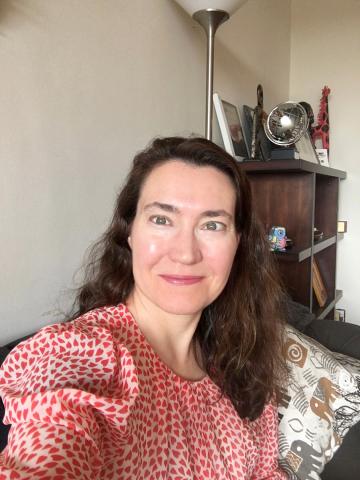Niche Field in Sudden Demand
FIC’s Viboud and Team Model, Predict COVID-19 Transmission Dynamics

Business is always booming in December and January for senior research scientist Dr. Cécile Viboud. That’s because she and her group at Fogarty International Center collect and analyze data about worldwide influenza trends, and flu season poses challenges for them every year. Usually, though, their work escapes notice beyond interested insiders. But winter 2020 was exceptional, of course. COVID-19 happened.
“There’s so much interest in disease-modeling right now—it’s crazy,” acknowledges Viboud, senior staff scientist, FIC’s Division of International Epidemiology and Population Studies. “My colleagues and I joke that our field of expertise is such a niche and nobody knows what we are doing and now everyone wants to talk to us.”
Viboud recalls coming across the disease caused by a novel coronavirus “in late December, early January by just looking at ProMED.”
According to its website, ProMED, or the Program for Monitoring Emerging Diseases, is an internet service provided by the International Society for Infectious Diseases “to identify unusual health events related to emerging and re-emerging infectious diseases and toxins affecting humans, animals and plants.”
“There were a few [posts] there that described interesting clusters of ‘pneumonia of unknown etiology in Wuhan,’” she says. In addition to those entries catching her attention, an outstanding Chinese postdoc in her group, Dr. Kaiyuan Sun, coincidentally became interested in the outbreak very early on.
“By mid-January,” Viboud notes, “Kaiyuan started compiling a lot of data from websites in Chinese that provided information from their local [Centers for Disease Control] about individual case descriptions and COVID-19 symptoms. So from there, we started doing work from these very early datasets and we haven’t stopped since.”
On a typical day, she and colleagues compile data from various sources, enter the information into computer applications and analyze the results to provide evidence for decisionmakers.
“There are different flavors of models—some are retrospective, trying to reconstruct what happened,” she explains. “Others are simulation models that try to project what could happen using different scenarios and interventions.”
Describing the prospective side, Viboud says, “Once we have transmission parameters that we’ve estimated from data, initially from China, we can put them in simulation models and use those to predict the outbreak trajectory in new locations. For instance, what if we stopped all interventions, if social distancing was relaxed now, what would happen? Would incidence rates increase? Maybe not right away—it takes time for cases to build up. If rates did rise again, what would happen if schools closed again, etc.? So you can explore the dynamics of the outbreak over long time periods.”
At NIH for 18 years, Viboud specializes in respiratory ailments. She calls COVID-19 her second pandemic, as she worked on swine flu too. Currently, the epidemiology division at Fogarty has a team of 16, with 7 assigned to work full-time on COVID-19.
“We’ve done a lot of our work on the retrospective [aspects], in particular working with Chinese and Korean data,” she points out. “Now the data from the U.S. and South Africa are just starting to become available. We get datasets weekly. We analyze epidemic curves—that’s our bread and butter. We look at case counts by onset date and study changes in transmission intensity over time and by geography. Typically, with this epidemic, you start with a high transmission rate, when the population is not aware of the outbreak and hasn’t applied an intervention.”
These days, work starts with an eye trained to media, Viboud says. “So I look at the news when I wake up, particularly case and death counts. I look closely at the decrease in case counts that we’re starting to see in Europe and also the U.S. and try to make sense of why deaths keep rising in some places. We know that deaths are substantially delayed from infection.”
Her group is, of course, intensely focused on informing next strategies in the global crisis.
“Right now, we’re looking at the impact of social distancing in reducing contacts and also stopping transmission,” she says. “We’re also looking at the impact of contact-tracing. If we did contact-tracing very intensively, would that be enough to stop transmission? That’s a key question now in the U.S., as we try to relax social-distancing measures. What do we do next, so that it doesn’t come back?”
Balanced with her research, however, Viboud—like everyone else—grapples with living in an era filled with unusual conditions and circumstances, and their effects.
“What’s really great is that mathematical modeling and the type of analytic work we’re doing can be done anywhere,” Viboud concludes. “We work with partners all over the world and remote collaboration is something we do all the time, so teleworking is not much of an issue…It is exciting but also sobering knowing that what you do matters, and that it could also change policy and potentially have an economic impact. Usually we work in situations where our outputs are much more theoretical, and we now have this added pressure.”
Nevertheless, she says, what remains gratifying is that her field by its very nature routinely leads to a great deal of cooperation; COVID-19 has amplified the importance and value of international sharing.
“Right now, there’s a lot of effort to compare outputs from different models and geographies,” she explains. “Because there’s so much uncertainty with this virus—because it’s new—we really need to hear from different models and different approaches to make sure what we decide is based on the best evidence that we have. So that’s really exciting, but I can also see the toll that it’s taking on everyone in the modeling community.”
